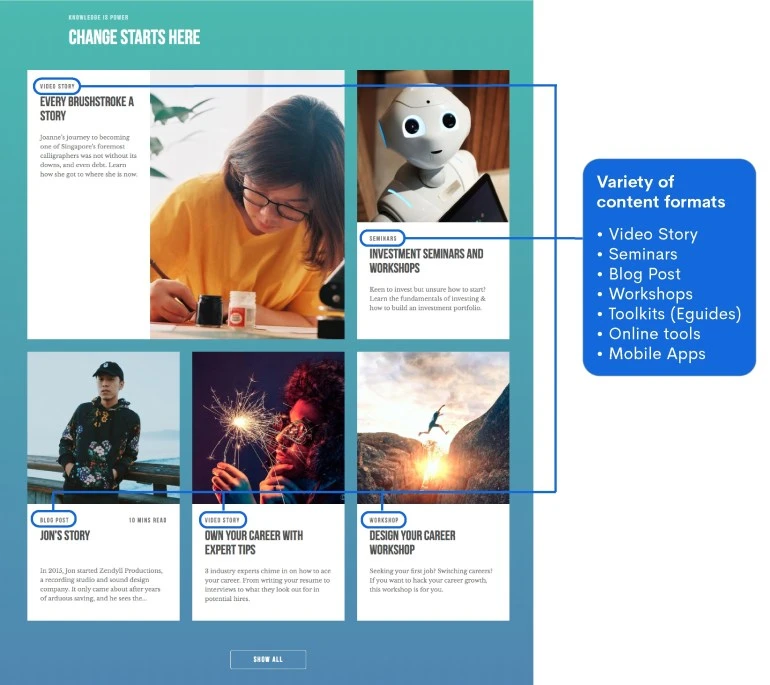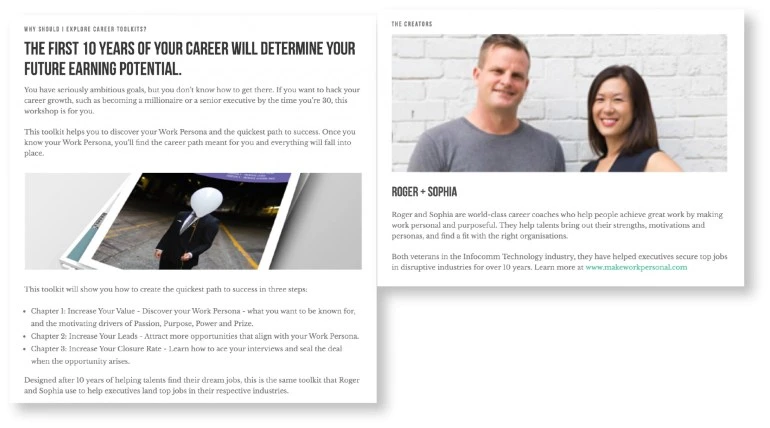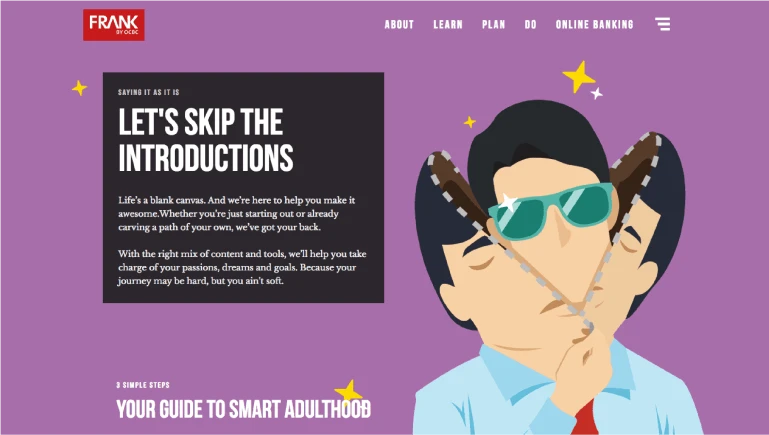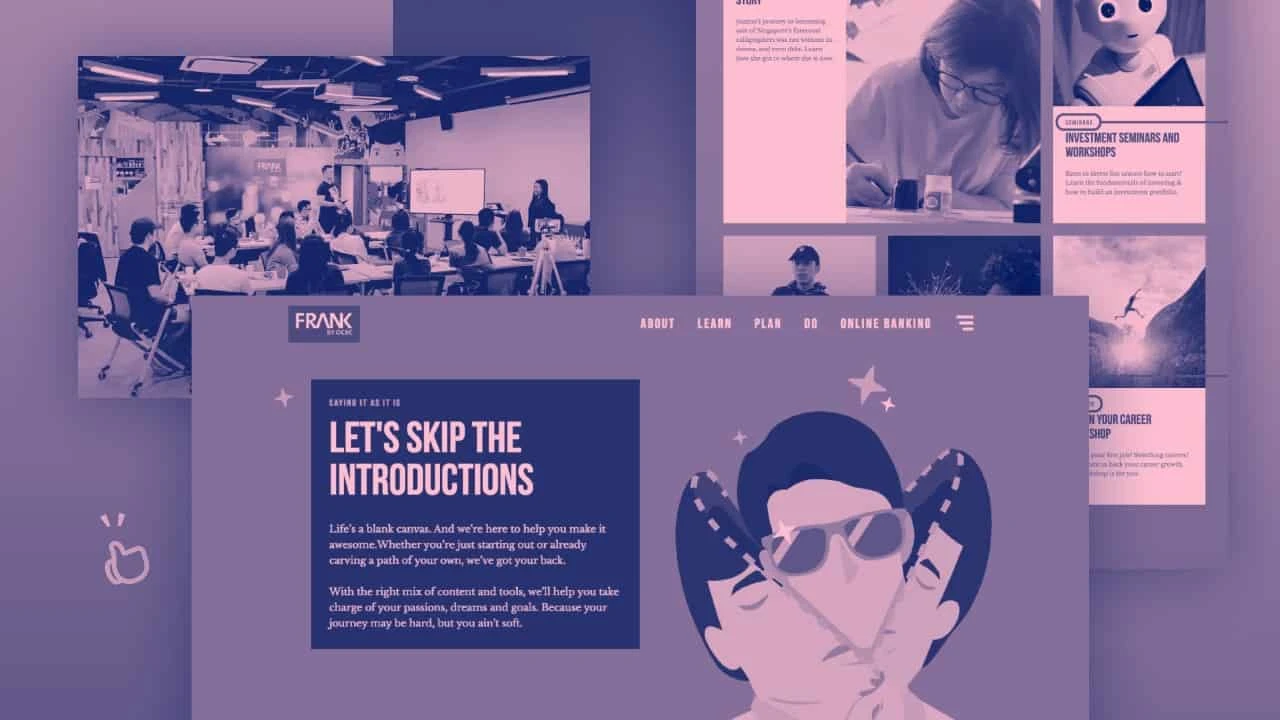It’s 2011 and OCBC Bank is sitting at a critical juncture. The financial services giant is starting to recognise that its public outreach efforts – mainly comprising of advertisements and long reports – were not engaging a segment of younger, digital-savvy customers, primary those between the ages of 16 to 29. It’s not a surprising fact. Findings from multiple research studies were pointing in the same direction: that millennials were starting to feel disconnected from the financial services industry, which they deemed to be dry and technical. Instead, they yearned for personal, authentic interactions with brands.
OCBC needed to radically shift its approach in engaging millennials, a promising group headed towards their peak purchasing power, thus representing the future growth trajectory for the bank and most businesses.
A sub-brand, FRANK by OCBC, was launched in May 2011. A first-of-its-kind banking programme, FRANK was OCBC’s answer to targeting youths and young working adults.
With its launch, FRANK started making waves online with their use of social media — a norm today but a bold step in 2011. The FRANK by OCBC website was also built from the ground up, specifically targeted at youths and the young working audience – an effort which clinched Gold in the 2016 Singapore Good Design Mark Awards.
But going digital wasn’t the only thing FRANK did. To truly resonate with youths, they knew that they had to create relevant experiences throughout the entire customer journey, from online to offline. One example of how FRANK tailored offline engagement to reach youths was the FRANK card designs. Through research conducted by OCBC, they found that this segment of customers who grew up in the age of the Internet could indulge in endless personalisation and self-expression. In response, FRANK introduced over 120 attractive card designs at launch. To date, the array of card designs are still the biggest draw for many of their target customers.
Banks can’t stay the course. The financial services sector needs to constantly relook at its brand narrative, customer experience and product offerings to see how they can best engage youths, whose preferences are ever-evolving. The explosion of fintech startups and innovations in the finance industry today has also given consumers more reasons to shift away from traditional banking.
To find out more about the strategies behind FRANK, we sat down with Genevieve Gay, Head of Youth Segment, Advertising & Brand at OCBC to take a deep dive into her team’s approach to understanding and engaging millennials.
Observe customer interactions
Improving customer experience calls for a deeper understanding of customers, paying careful attention to their interests, needs and pain points. These were some of the steps the marketing team took to glean valuable insights.
Assemble an agile team
The team behind the content marketing initiatives at FRANK is made up of talents from various departments, each member serving a different function. As Gay adds, “No one has a monopoly on ideas.” These talents include videographers, photographers, user experience designers, product designers, as well as marketers from relevant teams in OCBC. Together, they form a cross-functional and agile marketing team that can build upon each other’s experience and build a diverse pool of ideas for each initiative.
Understand the topics their target group values
This can be a daunting task. The FRANK team has narrowed down their approach to relevant platforms and channels, as well as topics and keywords. Social intelligence tools help with discovering trending topics among youths, but they recognise that this isn’t sufficiently comprehensive. To accurately get the right pulse of what youths are interested in, Gay’s team also frequently looks out for niche interest groups on Telegram and local forum Hardwarezone, among others.
Conduct regular brainstorming sessions
Recognising that trends come and go very quickly, Gay and her team regularly brainstorm topics of interest to pre-plan content, drawing from their extensive media research. FRANK also works with external partners and agencies. With every partnership, the team ensures that they get the ball rolling early on by engaging them to brainstorm fresh angles and ideas.
As consumers increasingly expect immediate service and hyper-personalisation, another facet of the observation phase is understanding how the customer interacts with the FRANK brand. How do they consume FRANK’s content? In what ways do they respond to FRANK’s marketing campaigns? Does the narrative resonate with young millennials? What does it take to convert a customer? All the work put into understanding the customer is a necessary first step to building trust with young millennials.
FRANK’s marketing strategy is mainly data-driven. Gay shares that all the content published on the FRANK website has been meticulously planned and designed based on multiple rounds of A/B testing for optimal user experience. For example, the website content is segmented into three pillars: Learn, Plan and Do, to form a comprehensive journey towards financial responsibility.

In late-2017, OCBC and StarHub announced a strategic partnership to drive Singapore’s collaborative economy. Both companies have committed to investing S$6 million in research and technology over the next 12 months in a bid to uncover more profound data insights, with the expectation that both partners’ customers would benefit from greater experiences, offers and services delivered through their research. The focus of the first phase of the collaboration is to better understand customers’ needs and create more relevant solutions and superior customer experience across industries.
Through this strategic partnership, FRANK has gained insights into the youth segment through aggregated data of mobile phone usage, internet browsing behaviours and niche interest groups that Gay and her team have yet to tap into. Gay says, “We see huge potential to cross-share data, customise offers and solutions to customers, and create new data-informed solutions that neither organisations could deliver on our own.”
Engage effectively
Providing ideal customer experiences also requires teams to identify key conversion goals, and from there, customise the customer journeys accordingly. FRANK does it by engaging customers with useful content and a bold, authentic brand narrative.
Provide useful and relevant content
“The old way of marketing is talking at customers and interrupting for attention,” Gay says. “The new way of marketing, especially with digital natives, is to provide useful and relevant content that they want to talk about and engage with.”

FRANK’s online platform offers a variety of useful content, from e-guides to bite-size articles and videos that cater specifically to the financial needs of youths. Every piece of content is designed to be actionable, in a bid to increase user engagement. Content that has too much lofty information but without practical tips, tends to have user drop-offs.
The brand also prioritises user experience over promotional or brand information. The goal of FRANK’s content marketing efforts has been to provide youths with the tools to kick-start a positive habit of saving and thinking about their finances, rather than to push FRANK’s products.
CASE STUDY: CAREER WORKSHOP

The most direct and effective way that FRANK empowers their customers is through seminars and workshops. They equip youths with practical skills they need in their transition to adulthood. One event FRANK organised was, ‘Design Your Career Workshop’, hosted by world-class career coaches. From the get-go, the workshop was organised with young millennials in mind, to empower them with the skills they needed to position themselves well in front of potential employers.

For those who couldn’t attend the oversubscribed event, FRANK also offered website visitors a ‘Career Toolkit’. It is an e-guide packed with practical tips, checklists and sage advice to help young millennials carve out their career path.
‘Saying it as it is’

More than a slogan or a catchphrase, FRANK takes ‘saying it as it is’ as a philosophy and approach behind all that they do. Gay says, “Our work must always pass this stringent test: Is it FRANK enough? And is it as honest and truthful as our tagline ‘Saying It As It Is’ demands?” This means pulling back on the jargon-filled tendencies of bank-speak, and it’s evident from the get-go. FRANK’s ‘About’ page features copy and artwork that illustrates the brand’s desire to shed stereotypes of how a bank interacts with its customers.
FRANK further demonstrates this philosophy through authentic storytelling. When collaborating with agencies and influencers, the marketing team introduces partners to their internal brand guide early on, and actively works with them to brainstorm fresh campaign ideas and angles.
CASE STUDY: COLLABORATION WITH THE LETTER J SUPPLY

- Joanne Lim’s card design for FRANK is part of a series of collaborations with local artists.*
The feature story on Joanne Lim focused on her artistic and financial journey in opening her studio and company. Not your typical social media influencer, Lim founded and runs a modern calligraphy studio that has grown a sizeable following. She spoke to a specific segment of youths who were exploring their passion for creative arts. She was frank about her own financial difficulties and her inexperience, especially in the earlier days of becoming a young business owner.
Gay believes that the topic of money management underpins loftier goals like travelling the world or starting a business. Accompanying the video was a short interview with Joanne where she shared financial advice to young creatives aspiring to make a career out of their passion. Out of her personal experiences, the advice that Joanne shared was practical and grounded in financial wisdom, giving the story an added layer of authority. By encouraging partners to ‘say(ing) it as it is’, FRANK can convey stories and narratives in a refreshingly authentic way, while still tapping on the expertise of a contributor network.
Review and optimise
As with all marketing campaigns, the discipline requires an ongoing process of testing, reviewing and adjusting. FRANK does this by focusing on metrics that capture customer feedback, which offers them invaluable insights for improvement.
“The bank of the future needs to be digitally powered by data to ensure customer-centricity,” Gay says.
Here are the metrics that her team looks at to improve customer experience:
-
Brand association
-
Net Promoter Scores
-
Content engagement
Brand association
Brand association refers to the qualities that customers associate with the brand. With FRANK’s investment in brand messaging, it is no surprise that Gay and her team pay close attention to brand association. While general brand sentiment can be hard to measure, the marketing team conducts regular surveys and focus groups to understand what young millennials think of FRANK.
Net Promoter Scores
FRANK uses the Net Promoter Score to measure the performance of their customer experience improvement efforts. FRANK arrives at their Net Promoter Score through short surveys, which includes questions such as: “On a scale of 1-10: How likely would you recommend FRANK by OCBC to a friend or colleague?” These short surveys take place in stores as well as through online channels. Respondents are then grouped into promoters, passives or detractors, based on their scores. The final Net Promoter Score is determined by subtracting the percentage of detractors from the percentage of promoters.
Content Engagement Metrics
With a predominantly digital presence, FRANK looks at content engagement across many platforms. For content hosted on their website and blog, the marketing team focuses on time spent on page, bounce rates and pages per session. They conduct regular A/B testing with every customer-facing asset that they send out or publish on digital channels. For example, they look at which SMS phrasing or email headline would work better with their target audience. Through this process, they have also learnt that original commissioned artwork and creatives also perform better than stock images.
When asked about the success of their content marketing efforts, Gay shares, “Investments in content have increased unique site visits 46% year-on-year with longer engagement for blog articles after our site revamp.”
Next steps
Gaining the trust of millennials is a difficult task. FRANK has given us a look at how prioritising their customer experience and engagement is key to winning them over. Here are some simple steps you can take to improve your brand’s customer experience.
Observe customer interactions
As marketers, it’s easy to fall into the trap of focusing too much on one channel or one touch point. Understand the customer’s journey through their eyes. How do they interact with your brand before, during and after purchase? Start by taking stock of all the channels that your brand uses to reach customers and pay attention to metrics that reveal customer preferences and behaviours.
Engage effectively
Use the insights gained from the observation stage to engage your audience in authentic conversations. Personalisation and relevance is key to winning over today’s customers. With new technologies readily available to marketers today, brands can easily offer hyper-personalised content and offerings, based on search intent, browsing behaviour and purchase history.
Review and optimise
Evaluate what metrics are most important to your brand. There is a plethora of parameters to look at, from brand sentiment to bounce rates. Which sets of metrics give you the clearest insight into how customers are experiencing your brand? Gay also shares that this process is not a one-off solution. “It is an investment to earn their trust and an engagement form throughout their journey to adulthood.”
